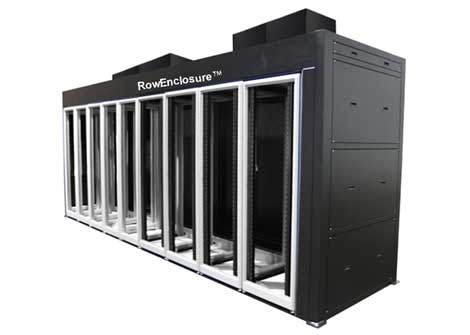
OpenGate Data Systems is introducing the EC30R Row Enclosure system to support power densities of up to 30 kilowatts per rack.
Is the data center industry ready for ultra-dense cabinets that use up to 30 kilowatts of power? OpenGate Data Systems is introducing new products next week to manage the cooling for racks with extraordinary power density. The company is rolling out an updated high-density version of its rack-top "smart chimney" for server cabinets, along with a containment framework to enclose entire rows of racks.
The new EC30R can cool cabinets using up to 30 kilowatts of power, an expansion from the OpenGate system's previous upper limit of 20 kilowatts. Power densities continue to trend higher in major densities, according to OpenGate CEO Mark Germagian, who said the company now has customers running cabinets requiring up to 22 kilowatts of power.
“The flexibility of the EC30R allows sizing as needed for new spaces, or for retrofitting existing spaces to reclaim wasted cooling capacity,” said Germagian. “The EC30R is an expansion of the EC10 and EC20 Containment Cooling systems that have been shipping for two years."
OpenGate Data has focused on cabinet-level containment systems that effectively eliminate the hot aisle by removing waste heat from servers through a chimney system that brings the air directly into an overhead plenum (air chamber) that returns the hot air to the air handlers or CRACs (computer room air conditioners). The company's UnityCooling software provides automated cooling management, allowing the rack-top system to "talk" with air handling units to manage changing heat loads within a cabinet (see a video demo of OpenGate's technology).
Managing Entire Rows
OpenGate is also announcing RowEnclosure, a system that provides full containment for up to 12 racks of equipment in a single row. The system can accommodate racks of different sizes, Germagian says, while using the Unity Cooling software to manage the entire row as a unit, maintaining a common temperature setting across racks with different power densities.
The ability to manage a breadth of rack sizes and compute loads will be of particular interest to hosting and colocation service providers, who support customers with different types of equipment and power densities.
Germagian said the increasing use of variable speed fans in servers places a premium on cooling systems that can respond to regular changes in the environment inside a cabinet or row. Variable-speed fans allow users to conserve energy by adjusting fan activity in response to computing loads. "It plays well in this market where Energy Star servers with variable speed fans that will spin up and spin down," said Germagian.
Taller Racks, Higher Densities
Another trend that presents cooling challenges is the move towards taller racks, particular among large users seeking to get more mileage from their data center space with racks as tall as nine feet. Germagian said this can also result in higher power densities.
While rising power densities are a challenge, the growing adoption of containment systems is being driven by the need to cut down waste and inefficient air management - even when you're not running 20 or 30 kilowatts per racks. "The main benefit is that you never let the heat out of the cabinet," said Germagian. "We see customers with 100 and 115 degree heat coming out of the back of their servers."
Containment allows these customers to continue to use existing perimeter CRAC units to cool their equipment, rather than having to invest capital on in-row cooling units, he said.



